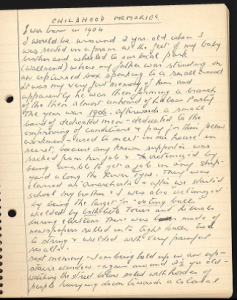An Introduction to Wilhelmina Tobias
An Introduction: Tobias, Wilhelmina
Wilhelmina Tobias’s father, a ship worker, speaks from his upturned box to a small crowd outside his local bank in Wallsend. His audience are members of the trade union movement, the local working classes and his wife and young daughter. He is speaking with the ultimate goal of forming a local branch of the Labour Party.
Figure 1 Wilhelmina Tobias father worked on the docks sited on the banks of the Tyne River in Newcastle
The year is 1906 and the Labour Representation Committee or LRC have won 29 seats in the most recent election with the help of a secret pact with the Liberal chief whip to avoid standing against each other and splitting the vote. In the immediate aftermath of the election the group’s Members of Parliament decided to adopt the name ‘The Labour Party’ formally. In spite of this success, it was still dangerous to be associated with the Labour and union movements so Mr Tobias and his colleagues would go on to conduct secret meetings in their houses over the following years whilst forming a union of ship workers as well as a local branch of the Labour Party in the north east.
This is my author Wilhelmina’s first memory and it involves an association with socialist politics that follows her through life. Labour supporters were labelled anarchists and faced being simultaneously fired from their jobs and blacklisted from getting others. Thanks to her father’s political affiliations she and her brother were the target of the Tory- and the Liberal-supporting children in the playground. Particularly at election time they fell afoul of what are described as ‘voting balls’ – pages of newspaper tightly wrapped into a ball and tied at the end of a piece of string before being wielded like a ball and chain – with painful results.
Wilhelmina Tobias has hand written a collection of her memories under the title ‘Childhood Memories’, consisting of around 5,000 words, that begin with her birth in 1904. At first the memoir deals with Wilhelmina’s first recollections as a child in chronological order beginning with her very first memory. As the memoir progresses Wilhelmina addresses different aspects of her childhood under sub-headings that cover topics such as School, Entertainment, Christenings, Weddings and Funerals.
Figure 2 The first page of the memoir, showing handwriting
Wilhelmina describes her lifestyle in Wallsend, Newcastle, mostly by concentrating on what was done differently when she was a child, for instance she highlights the lack of toilet paper and the lack of electricity. Other examples of this are evident in her descriptions of first seeing an aeroplane and a zeppelin. Her recollections include many household rituals, for instance washdays and ironing days, which are described in great detail and capture the socially inclusive events they were at the turn of the 20th century.
Being only 22 pages long and covering just the years from 1904 up until 1915 it can be fairly light in detail but offers a deeply personal account of life. Wilhelmina’s recollections of the Great War are perhaps the best example of this. There are only two pages dedicated to it though these include her father enlisting and his subsequent death at the front. She echoes other working class auto biographers’ styles of writing, avoiding writing at length about their personal lives and including cliché as a tool to enable her to relate personal experiences, making her memoir typical of the time. The fast paced environment of cultural and technological advancement evident at the beginning of the century make Wilhelmina Thomas’ autobiography a memoir that a keen historian can enjoy.th century.
Tobias, Wilhelmina, ‘Childhood Memories’, MS pp.22 (c, 5,000 words). Brunel University Library.



Leave a Reply